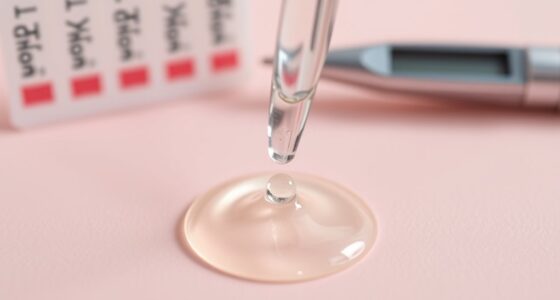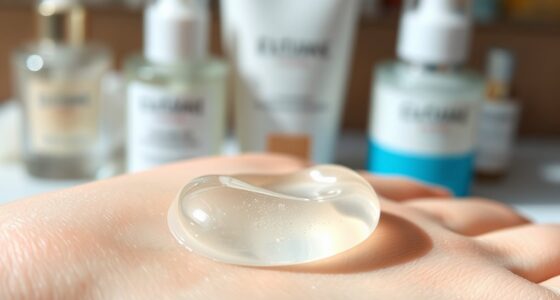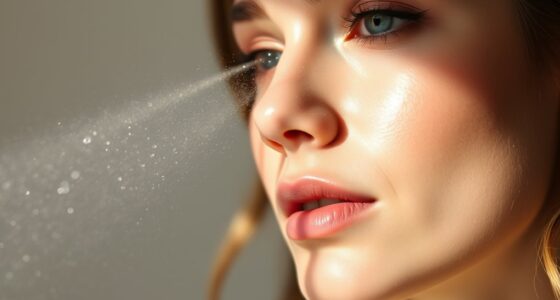To maximize product effectiveness at night, start with a gentle cleanse to remove dirt, oil, and makeup, then apply a hydrating toner and essence for a fresh base. Layer lightweight serums and targeted treatments, focusing on ingredients like antioxidants or hyaluronic acid. Follow with a suitable moisturizer to lock in hydration, and finish with an occlusive product to seal everything in. Keep going to discover how to customize each step for your skin’s needs.
Key Takeaways
- Start with thorough cleansing and double cleansing if needed to remove impurities and enhance absorption.
- Apply toners and essences to hydrate and prepare the skin for subsequent treatments.
- Layer lightweight serums and active ingredients from thin to thick textures for targeted benefits.
- Seal in active ingredients with a suitable moisturizer to maximize overnight absorption and hydration.
- Finish with occlusive products to lock in moisture and protect the skin barrier during sleep.
Cleansing and Preparing the Skin
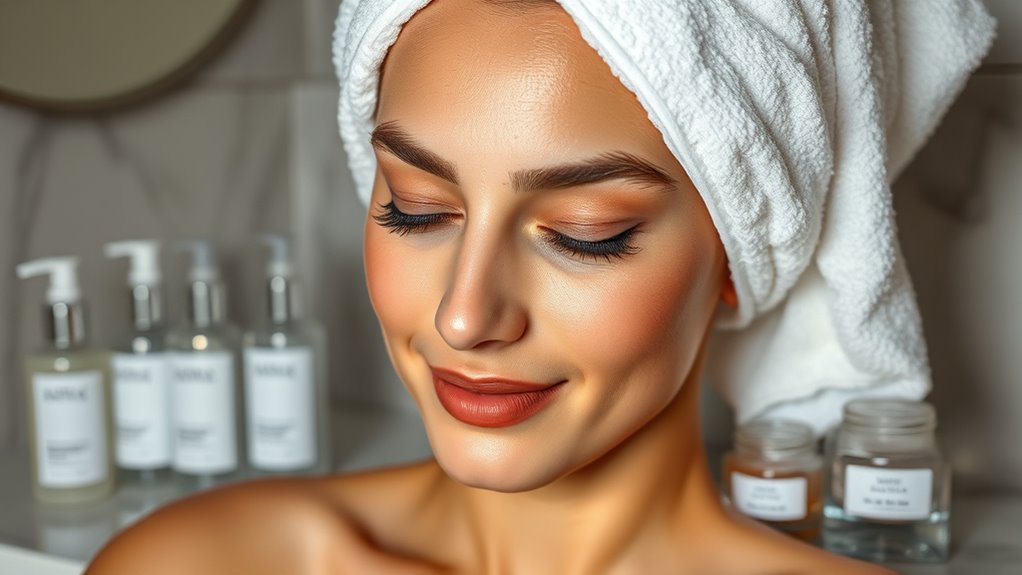
Before applying any nighttime treatments, it’s essential to start with cleansing and preparing your skin. Begin by removing dirt, oil, and makeup with a gentle cleanser suited to your skin type. This step clears the surface, allowing your skin to breathe and absorb subsequent products more effectively. Use lukewarm water to rinse thoroughly, avoiding hot water that can strip moisture. Pat your face dry with a soft towel—don’t rub, as that can irritate your skin. If you wear makeup or sunscreen, consider double cleansing for a deeper clean. Proper cleansing not only refreshes your skin but also lays a clean foundation for your entire skincare routine. Additionally, ensuring your cleanser is effective at removing residues can enhance the product absorption of your skincare products. This step is crucial for maximizing the benefits of the products you’ll apply afterward.
Applying Toners and Essences

After thoroughly cleansing your skin, the next step is to apply toners and essences to enhance hydration and prepare your skin for subsequent treatments. Start by pouring a small amount of toner onto a cotton pad or your fingertips. Gently sweep or pat it onto your face, focusing on areas that need extra hydration or balance. Choose a toner suited for your skin type—hydrating for dry skin, balancing for oily or acne-prone skin. Follow with an essence by dispensing a few drops into your palms and patting it into your skin. Essences are more concentrated, so they help boost moisture and improve the absorption of later skincare products. This step guarantees your skin is thoroughly prepped, making your nighttime routine more effective and your skin more receptive to the benefits of upcoming treatments. Using low-carb and keto-friendly ingredients in your skincare products can also support your overall health and skin wellness. Incorporating AI-driven insights can assist in selecting the most suitable products for your skin type, ensuring optimal results. Paying attention to air quality can further enhance your skincare routine by reducing environmental stressors that impact skin health. Monitoring the skin’s response to these products can help optimize your routine and prevent adverse reactions. Additionally, choosing trusted brands like Patchology, known for product effectiveness, can ensure you’re using high-quality formulations that deliver real results.
Layering Serums and Treatments
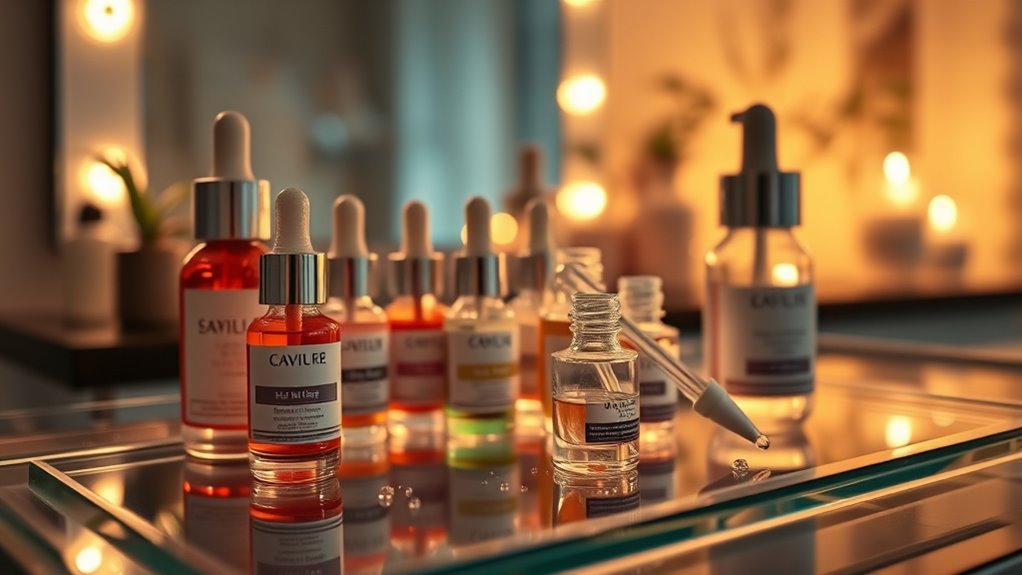
Once your essences have absorbed, you can begin layering serums and treatments to target specific skin concerns. Start with the lightest formulas and work your way up to thicker textures. Here’s how:
- Apply a serum with antioxidants to combat free radicals and brighten your complexion.
- Follow with a treatment containing active ingredients like hyaluronic acid or niacinamide for hydration and skin barrier support.
- Use a spot treatment if needed, focusing on problem areas like blemishes or dark spots.
- Finish with specialized treatments, such as retinol or peptides, to promote renewal and firmness. Additionally, understanding the importance of skin barrier health can help you select the most suitable products for your skincare routine.
Moisturizing and Locking in Hydration
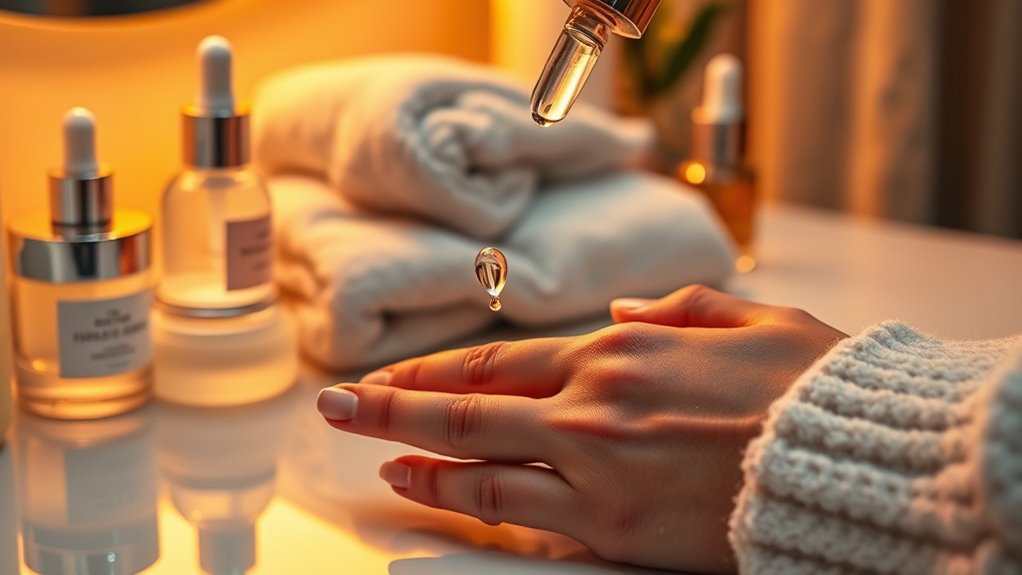
To effectively lock in all the layers of your nighttime skincare, you need to apply a moisturizer that suits your skin type. If you have dry skin, choose a rich, emollient formula to restore moisture and strengthen your skin barrier. For oily or acne-prone skin, opt for a lightweight, oil-free moisturizer that hydrates without clogging pores. Apply your moisturizer evenly across your face and neck, gently massaging it in to enhance absorption. This step seals in the active ingredients from your serums and treatments, maximizing their benefits overnight. Proper moisturizing prevents moisture loss and maintains skin elasticity. Additionally, incorporating sound design techniques into skincare product audio descriptions can improve consumer engagement and understanding of product benefits. Remember, consistency is key; a good moisturizer tailored to your skin’s needs keeps your skin hydrated, plump, and healthy by morning.
Finishing With Occlusive Products
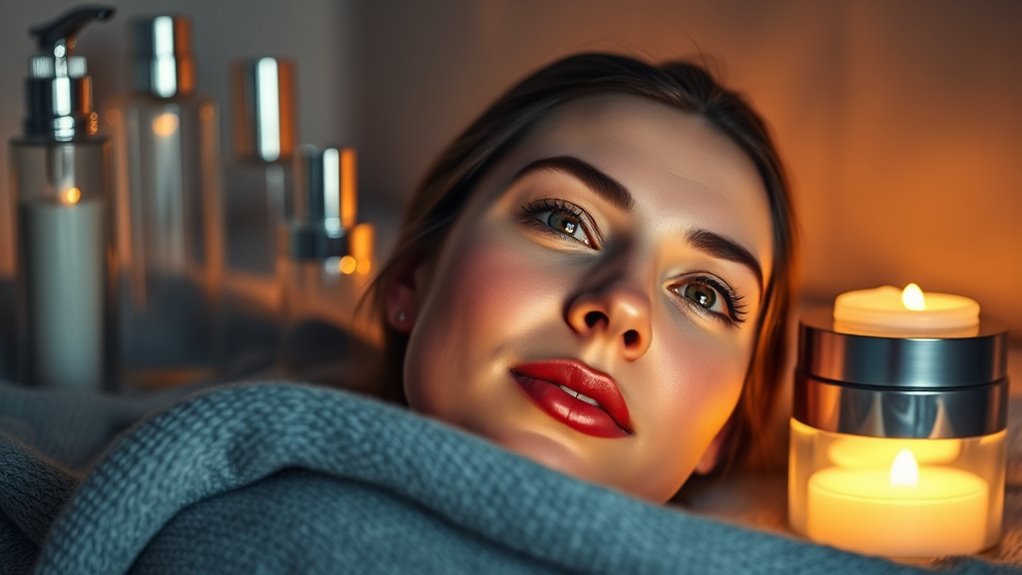
Finishing with occlusive products is a crucial step to lock in all the hydration and active ingredients from your previous skincare layers. These products create a barrier that prevents moisture loss and enhances absorption. Here’s how to make the most of this step:
- Choose an occlusive that suits your skin type—like a thick cream or balm.
- Apply it evenly over your face, focusing on areas prone to dryness.
- Gently pat to ensure it seals in the products underneath.
- Avoid over-applying; a thin, even layer is enough to lock everything in.
- For Halloween, consider using specialized styling products designed for maximum hold without compromising skin health, especially after extensive makeup or wig styling.
- Incorporating data privacy considerations can help ensure your skincare data and preferences are protected when using digital skincare tools or apps.
- Using advanced natural language processing can assist in understanding product ingredients and recommendations tailored to your skin needs.
- Remember that product layering is essential for achieving optimal results from your skincare routine, and sealing in these layers with an occlusive ensures maximum effectiveness.
Frequently Asked Questions
How Long Should I Wait Between Each Skincare Step?
When you’re applying skincare products, it’s best to wait about 30 seconds to a minute between each step. This allows your skin to absorb each product properly and prevents them from pilling or sliding off. If you’re using thicker creams or oils, give it a bit more time—around 1-2 minutes. Pay attention to how your skin feels; if it’s still tacky, wait a little longer before moving on.
Can I Skip Any Steps if I’M in a Hurry?
Think of your skincare routine as a symphony; every step plays a crucial role. If you’re in a rush, you can skip some steps, but it’s like leaving notes out of a song — the melody won’t be as beautiful. Focus on cleansing and moisturizing, which are indispensable. Skip toner or serums if needed, but don’t abandon your routine altogether. Prioritize what truly benefits your skin to keep the harmony intact.
Are There Products That Shouldn’T Be Layered Together?
You should avoid layering certain products together to prevent irritation or reduced effectiveness. For example, don’t combine strong acids with retinoids or vitamin C, as they can cause sensitivity. Also, steer clear of mixing benzoyl peroxide with exfoliating acids. Always check ingredient guidelines or do a patch test first. If you’re unsure, consult a dermatologist to guarantee your skincare routine is safe and effective.
How Often Should I Change My Nighttime Skincare Routine?
You should change your nighttime skincare routine when your skin’s needs change or if your current products cease functioning. Typically, every few months, reassess how your skin feels and looks. If you notice irritation, breakouts, or no improvement, it’s time to switch things up. Also, introduce new products gradually to avoid reactions. Adjusting your routine ensures your skin continues to get the care it needs.
What Ingredients Should I Avoid Combining for Optimal Results?
You should avoid combining ingredients like retinol and acids, such as AHAs or BHAs, as they can cause irritation and reduce effectiveness. Also, steer clear of mixing vitamin C with niacinamide, which can potentially deactivate each other. Always read product labels and wait a few minutes between applying different products. This way, you guarantee your skincare benefits are maximized without unnecessary irritation or compromised results.
Conclusion
By following this nighttime routine, you set the stage for your skin’s renewal, nurturing it like a gardener tending to delicate blooms under moonlight. Each step acts as a silent guardian, guiding your skin through its nightly rebirth. Embrace this ritual as a sacred dance between you and your skin, allowing your efforts to bloom into radiant, resilient beauty come morning. Trust in the process, and let your skin flourish like a garden awakened by the dawn.


